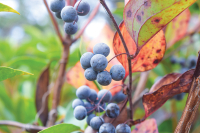Wildfire impacts range from barely there to complete char, but true effects remain to be seen
It’s a warmer-than-average January day, the contours of the mountains visible from the highway beneath a thin covering of leafless tree branches under a half-blue sky. A U.S. Forest Service Jeep travels west on U.S. 74, bypassing Franklin and hanging a right for the winding road that leads to Wayah Bald.
The vehicle pauses for a moment as it traverses a valley framed by Wayah’s upward-reaching face. The slope is mottled with patches of darkness that could almost pass for cloud shadows.
Add acreage to your spiritual landscape
Lots of folks like to study those molded relief maps of the region, the ones that show the upraised contours of the mountain ranges. Some have even pieced together the maps for the Southern Blue Ridge Province from Southwestern Virginia to North Georgia as wall hangings, making it possible to contemplate in miniature the glorious terrain we call home.
It’s pleasurable to sit in an easy chair on a rainy day and ponder the way the ridges join or meditate over how they might have looked before eons of erosion wore them down into their present configuration. Even more rewarding is a venture to a local vista for a panoramic look-see at the real thing.
In one sense, of course, high vistas are places that enable us to rise above our everyday humdrum existence and take in grand scenery, even when we don’t know exactly what we’re looking at. As one writer aptly phrased it, “There’s wonder and delight up there ... elbow room for the soul ... all you have to do is suspend judgment and analysis long enough simply to be there, on the mountain, experiencing it.”
Well, no one would want to fail to take in the beauty or be exhilarated, but we also shouldn’t forget that Blue Ridge vistas are windows that allow us to see and comprehend more truly. A little “analysis” from time to time won’t hurt.
On a clear day, you can observe the bare bones of the land and come to a fuller understanding of the exact lay of the land. The thoughtful choice of a series of strategic vistas in your particular section of the Blue Ridge will enable you to observe just where the major ranges abut and how the peaks, spurs, gaps, upland valleys, streams, rock cliffs, gorges, grassy balds and other topographical features fall into place. You will come away with a more precise notion of your place in the world.
Because we’ve lived in the Tuckasegee River valley on the southern edge of the Smokies for the last 40 or so years, my wife and I have concentrated our attention on the interior portion of the Southern Blue Ridge Province from the Great Smokies on the west and north, to the Nantahalas in the south, and the Balsams in the east. One of our greatest satisfactions while driving or walking is being able to look up and recognize specific peaks and ranges by name, to know how they interconnect and relate to the remote cove we live in. They have become old friends. Each new lookout visited, each new mountain range recognized by its distinctive shape adds acreage to our spiritual landscape.
Among our favorite vistas are Wayah Bald (5,342 feet) in the Nantahalas, Waterrock Knob (6,292 feet) in the Plott Balsams along the Blue Ridge Parkway, and Clingman’s Dome (6,643 feet) on the high divide of the Smokies along the N.C.-Tenn. state lines. All three can be reached directly by vehicle within a single day. When it’s clear, one can easily see the 30 or so miles from each of these vantage points to the other two corners in what is a vast triangle. This triangulation technique allows an observer to view a given terrain from various directions and fit together landscape in an efficient manner.
Waterrock Knob is a fun place to visit because it attracts such a mix of visitors: drive-by tourists looking for the next overlook; thoughtful tourists savoring a special spot; plant enthusiasts seeking out species restricted to the northern hardwood and spruce-fir forests (yellow birch, spreading wood fern, mountain ash, etc.); birders looking for high-elevation species (ravens, golden-crowned kinglets, winter wrens, etc.); frisbee-catching college students; sunset and sunrise watchers; hikers, walkers, and strollers; and so on. I like remote, difficult-to-access spots, but I also like places where a diverse gathering of people are having fun. I like to watch them go about their chosen activities.
Just last week, I found out about the upcoming “Blue Ridge Parkway: Celebrating Heritage and Communities” event that will take place this coming Saturday at Waterrock Knob. Nevertheless, I wanted to support the event if possible. So I contacted BRP ranger Pam Mann and offered to do a nature walk and talk of about 45 minutes duration starting at 3 p.m. I’ll talk some about the geologic-geographic setting. I’ll have with me a handout for the field guides I use for general natural history as well as for trees, shrubs, vines, ferns, grasses and wildflowers in Western North Carolina. (And I’ll also bring copies of the actual books and source materials). Then we’ll go walking (slowly) and see what we may see. I hope that you will join me in support of one of our great national treasures.
George Ellison wrote the biographical introductions for the reissues of two Appalachian classics: Horace Kephart’s Our Southern Highlanders and James Mooney’s History, Myths, and Sacred Formulas of the Cherokees. In June 2005, a selection of his Back Then columns was published by The History Press in Charleston as Mountain Passages: Natural and Cultural History of Western North Carolina and the Great Smoky Mountains. Readers can contact him at P.O. Box 1262, Bryson City, N.C., 28713, or at This email address is being protected from spambots. You need JavaScript enabled to view it..
In search of hidden lookout towers
The line-up of hikes in the Lookout Tower Challenge spans Western North Carolina. Seven are located in the Nantahala National Forest, including Wayah Bald and Albert Mountain along the Appalachian Trail.
Five more towers can be found in the Great Smoky Mountains National Park, including Shuckstack, overlooking Fontana Dam, and Clingmans Dome, atop the highest peak in the park. And the Blue Ridge Parkway provides access to several more towers, like Fryingpan Mountain near the Pisgah Inn or Green Knob near Mt. Mitchell. Even the newly constructed tower atop Mt. Mitchell, eastern America’s highest peak, is included in the Challenge.
Hikers who make it to all 24 lookouts get an embroidered hiking patch and a certificate of completion from the Carolina Mountain Club. They also receive formal recognition at the hiking club’s annual dinner banquet and inclusion in its newsletter. But the greatest reward is the magnificent vistas afforded by the towers.
Here’s a list of all 24 towers in the challenge:
Nantahala mountains: Wayah Bald, Wesser Bald, Albert Mountain, Yellow Mountain, Panther Top, Cowee Bald, Joanna Bald.
Great Smoky Mountains National Park: Clingmans Dome, Shuckstack, Mt. Cammerer, Mt. Sterling, Mt. Noble.
Blue Ridge Parkway: Fryingpan Mountain, Green Knob, Mt. Mitchell, Barnett Knob, Flat Top Mountain.
Other Towers: Little Snowball, Rendezvous Mountain, Moores Knob, Chambers Mountain, Bearwallow Knob, Rich Mountain, Camp Creek Bald.
New shelter graces Wayah Bald
After Ann McDuff was struck and killed while riding her bicycle in February 2003, her husband, Larry, spearheaded a money-raising effort to build a shelter in her memory along the Appalachian Trail.









